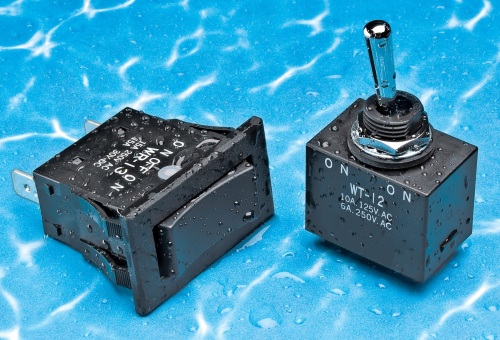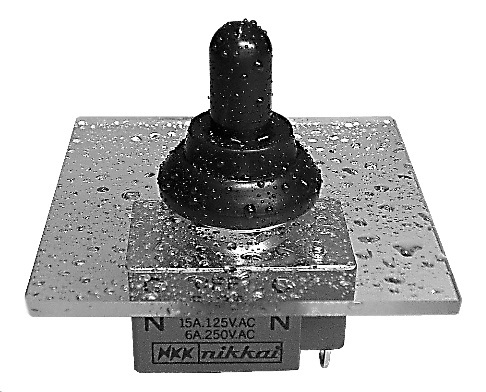Not all electronic equipment requires the use of sealed switches, but for those that do not use them it can be a costly and easily avoidable mistake. In fact, improperly installing a switch that is not designed for harsh environmental conditions can result in dramatically decreased switch life expectancy and even critical switch failure.

Thus, taking stock of environmental considerations is at the heart of designing and building electronic equipment that will serve its purpose and stand the test of time. Such considerations include potential exposure to extreme temperatures, water, chemicals, dust, oil and other types of contaminants.
It is also important to understand the primary sealed switch options available. These include IP-rated devices, splash proof boots and IP-rated devices with splash proof boots for maximum protection.
IP-rated switches are process sealed during manufacturing. They are subsequently guaranteed to resist certain environmental factors based on a ratings classification system established by the International Organization for Standardization's (ISO) IEC60529 standard.
This directive specifies the degree of protection of enclosures for low-voltage switches; specifically, protection of operators against contact with live or moving parts and the prevention of contamination by solid foreign material. The IP code is a specification used internationally and is similar to the National Electrical Manufacturers Association (NEMA) standard.
Common IP ratings include IP60, IP64, IP65 and IP67. Here is what each of these ratings means:
- IP60: Dust tight, but not protected against water.
- IP64: Dust tight and protected against splashing water from any direction.
- IP65: Dust tight and protected against low-pressure water jets from any direction.
- IP67: Dust tight and protected against effects of temporary immersion (up to 1 meter).
For designs requiring absolute precision, it is possible to rate to a specific IP rating and test according to a specific application's requirements. A few examples of testing include cycle tests, environmental tests and shock and vibration tests.
Unlike IP-rated devices, switches with splash proof boots do not provide a complete seal, but they do offer adequate protection against a variety of contaminating factors. However, common pitfalls that often come up during the boot installation process include improper panel material or panel thickness, the wrong boot for a specific switch, improper torque sequence or assembly process and insufficient thread engagement.
Boots also come in a variety of materials, each best suited to specific applications. Thus, it is also important to choose the right material for every environment. Six of the most common boot materials are:
- Silicone rubber, which provides very good hot, cold, ozone, aging and ultra-violet light resistance. It also offers very good flexibility, resilience and tensile strength over a wide temperature range. However, it is less tear resistant than some other materials, so proper care must be used during installation.
- Natural rubber, which is a great choice for panel seals and gaskets.
- Polyvinyl chloride (PVC), which is typically only used for dust proof covers as other materials provide superior resistance against all other types of contaminants.
- Nitrile butadiene rubber (NBR), which offers an excellent balance between protecting against oil and cold temperatures, good elasticity and prolonged performance. However, it provides inferior ozone resistance.
Ethylene propylene rubber (EPR), which while offering good hot, cold, dust, ozone and water proofing, it provides mediocre oil resistance.

Switch manufacturers can often retrofit most switch types, including pushbutton, rocker, rotary and toggle switches, with splash proof boots. The only exceptions are typically heavy-duty power rotary and slide switches. Half-boot options are also often available for toggle switches.
As a third sealed switch option, IP-rated devices with splash proof boots combine the sealed characteristics of IP-rated devices with an added splash proof boot. In many cases, using an IP-rated switch with a splash proof boot can be considered over design. However, if an application requiring an IP-rated switch impacts safety, either of equipment or human life, designing in such redundancy to ensure the highest level of protection against contamination and disastrous switch failure can be essential.
The ideal type of sealing method – whether that is an IP-rated device, a splash proof boot or a combination of the two – is largely dependent on the specific environment the switch will be used in. The most common harsh application environments are industrial control, medical and automotive/transportation/heavy equipment.
Several questions must be asked when selecting a switch for industrial control environments:
- What types of processes are being used in the facility?
- What is being made in the facility?
- Are there any contaminants in the air that could potentially affect switch performance?
All these factors are critical in the decision. In many cases, switches in industrial control environments will be subjected to fluids such as oils, cleaners or materials used in manufacturing processes. In such environments, where heavy machinery is often present, the consistent performance of a switch can become a safety issue with dire consequences.
Typically, industrial control environments require IP-rated switches. However, when safety is a factor in such environments, the redundancy of an IP-rated device with a splash proof boot is recommended. For example, consider the possibility that in such an environment, the switch housing could become compromised; thus, breaking the housing's seal. The protective boot would thus provide a second, but necessary barrier of defense against contaminants.
Key concerns in medical environments are the chemicals used for sterilization, which can impact the performance of the switch. Key specifications that must be considered include the chemicals the switch is subjected to, frequency of actuation and wear and tear. In many cases, IP-rated devices are not required for medical applications. Instead, splash proof boots are ideal for medical environments, since constant exposure to contaminants isn't likely, but semi-frequent routine exposure is expected. As mentioned, the harsh chemicals often used for sterilization in medical environments can impact switch performance.
Finally, a key characteristic of transportation/automotive/heavy equipment environments is assured prolonged or particularly obtrusive exposure to contaminants. These contaminants include dust, dirt and liquids. Such environments can also present temperature and vibration concerns, which could affect the fit and performance of a splash proof boot.
IP-rated switches are the best choice for transportation/automotive/heavy equipment applications. For most designs, an IP64 rated device, which is guaranteed dust tight and protected against splashing water from any direction, is sufficient.
While the above environmental considerations are crucial when deciding which sealed switch option is best, that does not mean one can forget about meeting the needs of end users, required technical specifications and any rules or regulations related to specific applications.
With all this in mind, selecting the right sealed switch might seem daunting, but the peace of mind that comes with implementing a properly sealed switch is well worth the challenge.
Advertisement
Learn more about NKK Switches





